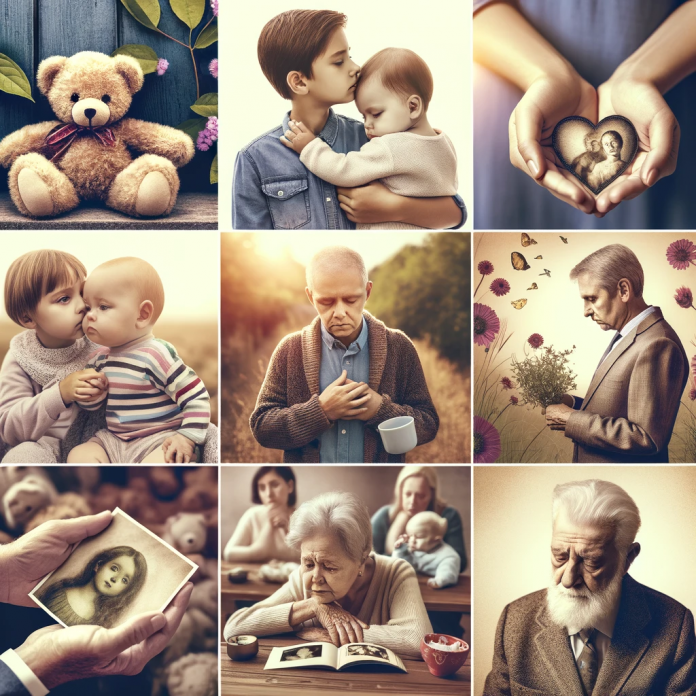Grief is a universal human experience, yet it manifests differently across various age groups. Understanding the nuances of the grieving process in different age groups can provide valuable insights into how to provide appropriate support and care. This comprehensive guide will delve into the intricacies of the grieving process, from infancy to old age.
The Grieving Process: A General Overview
Before we delve into the specifics of how grief affects different age groups, it's essential to understand the general process of grief. Grief is a natural response to loss, encompassing a range of emotions from sadness and anger to guilt and disbelief.
The grieving process is often depicted as a series of stages, including denial, anger, bargaining, depression, and acceptance. However, it's important to note that not everyone will experience all these stages, and the order may vary. Grief is a deeply personal experience, and it can be influenced by various factors, including the individual's personality, coping mechanisms, and support network.
Grief in Infants and Toddlers
While infants and toddlers may not fully understand the concept of death, they can still experience feelings of loss and separation. Their grief often manifests as changes in behavior, such as increased clinginess, regression in developmental milestones, or changes in eating and sleeping patterns.
Supporting a grieving infant or toddler involves providing a stable and comforting environment. Regular routines can provide a sense of security, while physical comfort, such as cuddles and soothing touch, can help alleviate distress.
Recognizing Signs of Grief in Infants and Toddlers
Infants and toddlers may not have the language skills to express their feelings, making it crucial for caregivers to recognize non-verbal signs of grief. These may include increased fussiness, changes in sleep patterns, and a decreased interest in play.
It's also important to note that toddlers may ask repetitive questions about the deceased as a way of making sense of their loss. Patience and reassurance can go a long way in helping them navigate their feelings.
Grief in Children
As children grow older, their understanding of death and loss evolves. They may start to understand death as a permanent state around the age of five. This understanding can bring about various emotions, including fear, confusion, and guilt.
Children may express their grief through play or artwork, and they may have many questions about death. It's important to answer these questions honestly and simply, without overwhelming them with too much information.
Supporting Grieving Children
Supporting a grieving child involves acknowledging their feelings and providing a safe space for them to express their emotions. It can be helpful to maintain routines to provide a sense of normalcy, while also allowing flexibility for moments of grief.
Children may also benefit from grief counseling or support groups, where they can connect with peers who are experiencing similar feelings.
Grief in Adolescents
Adolescents have a more mature understanding of death, but they may struggle with the intense emotions that come with grief. They may experience mood swings, changes in school performance, or engage in risk-taking behaviors.
Adolescents may also grapple with existential questions about life and death, and they may seek solace in their peer group. It's important to provide adolescents with the space to grieve in their own way, while also offering support and guidance.
Helping Adolescents Navigate Grief
Adolescents may resist overt displays of support, preferring to process their grief independently. However, they still need reassurance that their feelings are normal and that support is available when they need it.
Encouraging healthy coping mechanisms, such as exercise, journaling, or creative outlets, can be beneficial. It may also be helpful to connect adolescents with grief support groups or counseling services tailored to their age group.
Grief in Adults
Adults may experience a range of emotional, physical, and social changes in response to grief. They may feel a sense of disbelief, experience changes in appetite or sleep, or feel a disconnection from others.
Adults may also grapple with the practical implications of loss, such as financial changes or increased responsibilities. It's important to provide emotional support, while also assisting with practical matters where possible.
Supporting Grieving Adults
Supporting a grieving adult involves acknowledging their loss, offering a listening ear, and providing practical assistance where possible. It's also important to respect their grieving process and give them the space and time they need to heal.
Encouraging self-care, including healthy eating, regular exercise, and adequate sleep, can also be beneficial. Adults may also find comfort in grief support groups or counseling services.
Grief in the Elderly
Elderly individuals often face multiple losses, including the death of peers, loss of independence, or declining health. These losses can lead to feelings of loneliness, sadness, and fear.
Supporting an elderly person in grief involves acknowledging their loss, providing companionship, and helping them find ways to remember and honor their loved ones.
Understanding Grief in the Elderly
Elderly individuals may express their grief differently than younger individuals. They may be more likely to internalize their feelings, or they may express their grief through physical symptoms.
It's important to recognize these signs of grief and provide appropriate support. This may involve medical care for physical symptoms, as well as emotional support and companionship.
Understanding the grieving process in different age groups can help us provide the right support and care for our loved ones in times of loss. Remember, everyone's grief journey is unique, and there's no right or wrong way to grieve. The most important thing is to offer empathy, patience, and understanding.


-banner.png)





